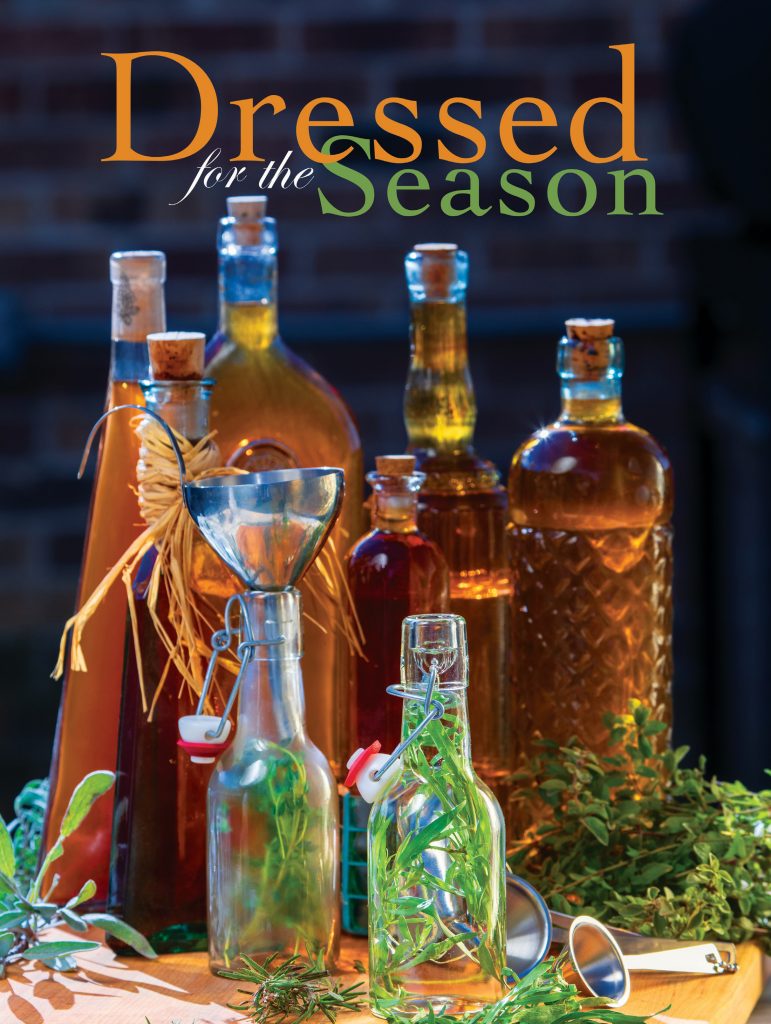Infusing flavor into homemade vinegars is almost as easy as boiling water.
The growing season is finally here. In another month, you’ll have a summer’s worth of fruits and vegetables to throw into fresh salads. Be ready with a variety of easy-to-make vinegars so your salads will be dressed appropriately.
Mix with mayonnaise, salt, pepper and a bit of olive oil for a delicious sandwich spread (thick) or salad dressing (thin). If garlic cloves are used, leave them in the vinegar solution for only 24 hours or less so the garlic can doesn’t overpower the flavor.
Herb Vinegar
- 2 cups distilled white vinegar
- ½ cup crushed or bruised herbs (chives, tarragon, basil, sage, thyme, mint, oregano, dill, marjoram or lavender)
- Place the vinegar in a heavy saucepan over medium-high heat.* Place the herbs in a glass container with a tight-fitting lid. When the vinegar is hot but not boiling, pour over the herbs. Cover and place in a dark place. Every other day for 4 weeks, shake or mix the contents. After 6 weeks, strain through a fine mesh sieve and discard the solids. Store in a cool, dark place. If using a metallic lid, place a piece of waxed paper over the opening before screwing on the lid.
Herbs de Provence Vinegar
- 2 cups distilled white vinegar
- 1 sprig fresh basil
- 1 sprig fresh lavender
- 1 sprig fresh rosemary
- 1 sprig fresh sage
- 1 sprig fresh thyme
- 1 bay leaf
- Place the vinegar in a heavy saucepan over medium-high heat. Place the herb sprigs in a glass container with a tight-fitting lid. When the vinegar is hot but not boiling, pour over the herbs. Cover and place in a dark place. Every other day for 4 weeks, shake or mix the contents. After 6 weeks, strain through a fine mesh sieve and discard the solids. Store in a cool, dark place. If using a metallic lid, place a piece of waxed paper over the opening before screwing on the lid.
Peppery Salad Vinegar
- 2 cups distilled white vinegar
- 15 black peppercorns
- 3 sprigs fresh chives
- 2 sprigs fresh parsley
- 2 sprigs fresh thyme or tarragon
- Place the vinegar in a heavy saucepan over medium-high heat. Place the peppercorns and herbs in a glass container with a tight-fitting lid. When the vinegar is hot but not boiling, pour over the peppercorn and herb mixture. Cover and place in a dark place. Every other day for 4 weeks, shake or mix the contents. After 6 weeks, strain through a fine mesh sieve and discard the solids. Store in a cool, dark place. If using a metallic lid, place a piece of waxed paper over the opening before screwing on the lid.
Pepper Sauce
Take some hot peppers and wash in cool water. Drain in a colander and pack tightly in canning jars. Bring some distilled white vinegar to a boil over medium-high heat and carefully pour over the peppers. Immediately cover the jars with the lids and allow to cool to room temperature on a wire rack. Refrigerate and bring to room temperature when ready to use.
Note: The longer this sauce sits, the better and more flavorful it becomes. Allow to stand at least 1 month before using.
Blueberry Vinegar
- 1 cup distilled white vinegar
- 1 cup fresh blueberries
- 6 whole cloves
- 2 cinnamon sticks
- 2 tablespoons honey
- In a small saucepan, combine the vinegar, blueberries, cloves, cinnamon sticks and honey over low heat. Stir constantly for 5 minutes and remove from heat. Cool to room temperature and cover. Refrigerate overnight. Strain through a fine mesh sieve and discard the solids. Refrigerate until ready to use.
Lemon Dill Vinegar
- 2 cups distilled white vinegar
- 4 sprigs fresh dill
- 1 fresh dill bloom
- Zest of 1 lemon
- 1 garlic clove, peeled
- 1 teaspoon mustard seeds
- Place the vinegar in a heavy saucepan over medium-high heat. Place the dill, dill bloom, zest, garlic and mustard seeds in a glass container with a tight-fitting lid. When the vinegar is hot but not boiling, pour over the herb mixture. Cover and place in a dark place. After 24 hours use tongs to remove and discard the garlic clove. Every other day, shake or mix the contents for 4 weeks. After 6 weeks, strain through a fine mesh sieve and discard the solids. Store in a cool, dark place. If using a metallic lid, place a piece of waxed paper over the opening before screwing on the lid.
Best Balsamic Vinaigrette Dressing
- 1 large garlic clove, peeled and cut in half lengthwise
- 3 tablespoons balsamic vinegar
- 1 tablespoon Dijon or stone-ground mustard
- ½ teaspoon salt
- ¼ teaspoon black pepper
- 1 cup olive oil
- Rub the cut sides of the garlic along the sides of a medium mixing bowl. Set the garlic aside and add the vinegar and mustard. Whisk until combined, and add the salt and pepper. While whisking, pour the oil in a steady stream into the bowl. When all the oil has been incorporated, add the garlic halves. Cover and let stand at room temperature for at least 30 minutes. With tongs, remove and discard the garlic. Transfer to a salad carafe and serve. Refrigerate any leftovers.
Fall Cider Vinegar
- ½cup cider vinegar
- ½cup apple juice
- 1 tablespoon sorghum syrup or molasses
- 1 small cinnamon stick
- ¼ teaspoon ground ginger
- Pinch of ground cloves
- Pinch of black pepper
- In a small saucepan over medium heat, combine the vinegar, apple juice, sorghum syrup or molasses, cinnamon, ginger, cloves and pepper. Stir constantly for 5 minutes. Remove from the heat and allow to cool to room temperature. Strain through a fine mesh sieve. Use or refrigerate for later use.
Red Wine Herb Vinegar
- 2 cups red wine vinegar
- 2 sprigs fresh oregano
- 2 sprigs fresh basil
- 2 sprigs fresh parsley
- 1 garlic clove, peeled
- 6 black peppercorns
- Place the vinegar in a heavy saucepan over medium-high heat. Place the herbs, garlic and peppercorns in a glass container with a tight-fitting lid. When the vinegar is hot but not boiling, pour over the herb mixture. Cover and place in a dark area. After 24 hours, use tongs to remove and discard the garlic clove. Every other day for 4 weeks, shake or mix the contents. After 6 weeks, strain through a fine mesh sieve and discard the solids. Store in a cool, dark place. If using a metallic lid, place a piece of waxed paper over the opening before screwing on the lid.
THE VIEW ON VINEGAR
Distilled white vinegar — This inexpensive vinegar is not actually distilled but rather is made from the fermentation of distilled alcohol. It is used when other flavors need to shine through.
Wine vinegar — This vinegar can be made from the natural yeasts in either red or white wine. Either is common for deglazing a pan.
Apple cider vinegar — Made from fermented apple cider, this vinegar has a slightly sweet flavor.
Balsamic vinegar — This exclusive vinegar is best if aged where it develops a syrup-like texture and a deep, rich color. It’s made from white grape must — the pulp, skin and seeds — and gets its color from the wood barrels in which it’s aged. The name “balsamic” means “balm-like,” which is a reference to its ease of digestion.
Rice vinegar — Made from fermented rice, this vinegar can be red, black or in the more common light tan color. Darker versions are more expensive and more difficult to find.
Malt vinegar — This is used to make Worcestershire sauce. It is made from malted barley that has been mashed, heated and then fermented.

ASK Chef Tammy
Dear Tammy,
I have just started using tofu and need some help. Can you please tell me how to use soft versions? I like it better than extra firm, but with the liquid, it is a bit too soft for me. In fact, it falls apart!
Mary Catherine
Dear Mary Catherine,
Drain the liquid from the tofu and place the block on a dinner plate in the sink. Place a second plate on top of the tofu. With your palm on the top plate, press down gently to extract more liquid and compress the tofu block. Tip the plates so the liquid drains away. Now it can be transferred to a cutting board and patted dry with paper towels. You can cut it into cubes or strips, and it will hold together beautifully.
Tammy Algood develops for The Tennessee Magazine recipes that feature farm-fresh Tennessee food. Those fresh, local ingredients will always add cleaner, more flavorful foods to your table. We recommend visiting local farms and farmers markets to find the freshest seasonal produce.
Email your cooking questions to Tammy Algood: talgood@tnelectric.org. You may be featured in the next issue of The Tennessee Magazine!
*You can simply add the herbs to room temperature vinegar if desired. Use the same instructions as above but realize that the hot method draws out more flavor from the fresh herbs.



